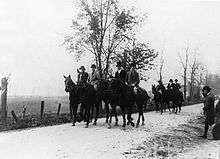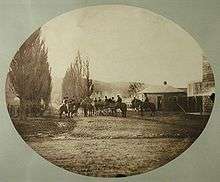Montreal Hunt

The Montreal Hunt is the oldest fox hunting club in North America. It was founded in 1826, by Lt.-Colonel The Hon. John Forsyth, of the Royal Montreal Cavalry.[1] Now entirely Francophone, in 1983 it was renamed the Club de Chasse à Courre de Montréal.
Early years
From 1826, the hounds of the fledgling Montreal Fox Hunt were hired from a local butcher.[2] In 1829, Forsyth purchased a pack of English foxhounds from his nephew's father-in-law, Mathew Bell, Seigneur de Trois-Rivières, and was named Master of the Hunt and of the Montreal Jockey Club. Before the Confederation of Canada, its members were for the most part made up of British officers stationed or settled at Montreal. To the eye, they were a rough bunch compared to their English counterparts, as one Englishman observed in 1831: "Equipped in dirty, dingy trousers and Wellington boots (they) took their leaps in very grand style; but who ever saw good leaping without a clean top?"[3]
The officers who hunted with the club during this time included many young aristocrats who, free from the usual rigours and restraints of home, enjoyed indulging in their eccentricities which usually involved them being on horseback. One such man was the young Lord Kerr, aide-de-camp to the Governor-General Lord Elgin (another Montreal huntsman). Kerr is remembered to have ridden his Hunter, "Marmion", into the Bank of Montreal to cash a cheque. On another occasion, he rode Marmion backwards through Côte-des-Neiges under a large umbrella when there was neither sun nor rain. The villagers merrily ran behind him thinking he was part of a circus - much to Kerr's delight.[4]
In the 1830s, the terrain on which the club hunted was very different to that of later, and particularly that of which the huntsman were used to in England. Under the Seigneurial system of New France, the farmland around Montreal was divided into narrow strips, which was not conducive to travelling far and fast. The ditches were broad and the fences too high, as one English foxhunter remarked at the time, it was "deucedly ugly country to ride over!"[5] The climate, which did not change, also posed a problem as snow usually fell by mid to late November, giving the club at best a three month window from the season's start in September.
Saving the hunt
In the early 1850s, the hunt narrowly escaped fading out of existence. Strychnine had recently been invented, and farmers and fur trappers alike were using it to kill foxes. Hunt members became frustrated by the lack of chase which saw numbers turning out dwindle drastically to just two. The Master of the Hunt then was Garrison officer John Stockley, of the Royal Artillery, who at the end of the season advertised in a New York newspaper that the hounds were for sale. Led by Ensign Charles Lutyens of the Lancashire Fusiliers, other members met at Donegana's Hotel and stepped up, forbidding Stockley to sell the hounds as they belonged to the club, and the club itself was financially sound. Lutyens was named the new Master of the Hunt and under him the club, and at the same time others across Canada saw a resurgence. Lord Elgin invited the Hunt to meet at his residence, Monklands, and they received invitiations to bring the hounds up to Quebec City. After fighting in the Crimean War, Lutyens (father of Edwin Lutyens) became an artist and one of his paintings, The Kill in the Fog, depicts a scene from his time with the Montreal Hunt.[6]
Golden era
.jpg)




In 1867, as Parliament was moved to the newly created Canadian capital of Ottawa, the Hunt club again saw a great many of its members disappear. But 1867 was also the first year that saw future patriarch of the Hunt, John Crawford (1812–1903), of Verdun House (later known as Crawford Park), elected Master. Crawford's father, a Northern Irish squire, sold up and emigrated to Montreal in 1828, chartering a small ship so that he could also take with him his beloved foxhounds.[7]
John Crawford and later Andrew Allan organized steeplechases at the Logan Farm near Montréal and in Outremont and Verdun. These helped to refinance and stabilize the club. Other meets were held at the Bel Air racecourse in Dorval (built in 1874 and later known as the Forest and Stream Club), creating strong ties between the Montreal Hunt and the Bel Air Jockey Club.
Montreal was at its financial peak during the years from 1880 to 1900. The club's members, who nearly all kept city homes in the Golden Square Mile, were growing more and more prosperous, and this only served to benefit the club. Previously known as either the Montreal Fox Hounds or the Montreal Hunt, in 1880 the latter became its official name. Under the dynamic leadership of Captain Edmund Campbell of Manoir Rouville-Campbell (son of Thomas Edmund Campbell), Ross Hutchins and especially Baron Alfred Baumgarten, new foxhounds were imported from Ireland and British rules for fox hunting were imposed. New hunt grounds were opened in Pointe-aux-Trembles and at Mont-Saint-Hilaire on the Campbell estate at Rouville.
During this period the club had roughly three hundred members and met three times a week. In the Senneville area there were roughly ten families who owned adjoining estates on which the club hunted across freely. W. W. Johnson mentioned in his Sketches of the late Depression: "The Stock Exchange held only a morning session on October, 13, 1882, since there was a hunt meeting that afternoon". Women were not 'official' members but they rode (side-saddle) to the hounds and attended all the social events. It was said that in 1914, when the daughter of a club member was seen riding astride down Sherbrooke Street "she caused more of a sensation locally than the assassination of the Archduke at Sarajevo!"[8]
It was during this period that Baumgarten built and donated an imposing brick clubhouse and kennels on DeLorimier Street, near Parthenais Street. By 1890, the Montreal Hunt had become the most prestigious social club in the city, bringing together prominent political, business and social leaders. In 1891, Sir H. Montagu Allan was elected Master of the Foxhounds and he put the club on a firm financial footing.
By the end of the 19th century, what was then known as the East End of Montréal (near today's Papineau (Montreal Metro)) was rapidly becoming industrialized. A new clubhouse and kennels were built at Côte-des-Neiges in 1898, where the club remained for the next 40 years. Its horse shows and competitions were hugely popular. A large number of documents belonging to the club were lost in the fire that damaged the Montreal Board of Trade building in January 1901, but the club was finally incorporated and given an official constitution in 1903.
During The Great War of 1914-1918 most of the club's members left to serve overseas. In 1920, the kennels were moved north of Montréal to Fresnière, near the village of Sainte-Scholastique. This area became the main hunting grounds for the club, though the clubhouse remained in Côte-des-Neiges until a fire in 1938 damaged it, hastening the transfer of all activities to Fresnière, away from encroaching urbanization. During the Second World War, the club came to a virtual standstill and many of its possessions were stored at members' homes or lent to military units in and around Montréal.[9]
Modern era
The first post-war hunt was held in 1947 at a time when many old members were retiring. This helped pave the way for the emergence of a new mainly Francophone membership. By the mid-1960s the club was predominantly French-speaking, and the documents in the fonds reflect this evolution. The first French Canadian Master was Roland Désourdy, elected in 1963. He was the impetus behind the opening of new hunting grounds in the Eastern Townships which became known as the Hunt South.
The Montreal Hunt celebrated its 150th anniversary in 1976 at the Ritz-Carlton Montreal (where the annual ball had been held every year since the opening of the hotel) with perhaps its last display of pomp and circumstance. The club had lost much of its former prestige, despite being closely associated with Olympic equestrian events. In 1983, the Montreal Hunt became officially known as the Club de Chasse à Courre de Montréal and acquired the status of a nonprofit organization. It continues to meet to this day.
Masters of the Hounds
- Lt.-Colonel The Hon. John Forsyth, of the Royal Montreal Cavalry. 1829
- Captain John Surtees Stockley (1816-1863), of the Royal Artillery. c.1845
- Captain Charles Henry Augustus Lutyens (1829-1915), of the Lancashire Fusiliers. c.1850
- Lt. James Ponsonby Cox (d.1880), of the Royal Engineers. 1854
- Dugald Lorn MacDougall (1811-1885), of Montreal. 1854-1859
- Captain (later Major-General Sir) Francis Walter de Winton (1835-1890), of the Royal Artillery
- W.M. Ramsay, of Montreal
- William Cunningham, of Montreal
- John Crawford (1812-1903), of Verdun House, Quebec. 1867
- Andrew Allan, of Montreal
- (Joseph) Ross Hutchins, of Montreal
- Capt. Edmund A. C. Campbell (1843-1902), of Manor Rouville, Quebec, formerly of the Gordon Highlanders
- Baron Alfred Baumgarten, of Montreal
- Hugh Paton (1852-1941), of "The Island" at L'Abord-à-Plouffe, near Montreal
- John Crawford (1812-1903), of Verdun House, Quebec. 1889 (second term)
- Sir Montague Allan, of Ravenscrag, Montreal. 1891
- Roland Désourdy (1917-2011), of Bromont, Quebec. 1963
See also
- John Irwin Cooper's The History of the Montreal Hunt 1826-1953 (Montréal, 1953)
References
- ↑ Memorial of the family of Forsyth de Fronsac
- ↑ Metropolitan Natures: Environmental Histories of Montreal (2011) By Stéphane Castonguay, Michèle Dagenais
- ↑ Metropolitan Natures: Environmental Histories of Montreal (2011) By Stéphane Castonguay, Michèle Dagenais
- ↑ Montreal Gazette - August 15, 1970
- ↑ Metropolitan Natures: Environmental Histories of Montreal (2011) By Stéphane Castonguay, Michèle Dagenais
- ↑ Edgar Allan Collard in the Montreal Gazette - August 15, 1970
- ↑ Montreal Gazette - August 15, 1970
- ↑ Remembrance of Grandeur - the Anglo-Protestant Elite of Montreal (1990) by Margaret Westley
- ↑ John Irwin Cooper, The History of the Montreal Hunt 1826-1953 (Montréal, Montreal Hunt, 1953)
